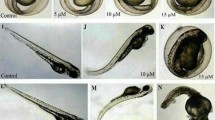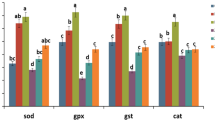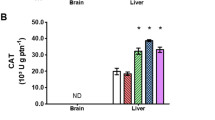Abstract
In recent years, because of its significant biological roles, the usage of boron has been started in animal feeding. In this research, it was aimed to investigate the ulexite’s action mechanism on the zebrafish brain with an evaluation of the oxidative parameters. The adult zebrafish were exposed to four ulexite doses (5, 10, 20, and 40 mg/l) in a static test apparatus for 96 h. For assessing the oxidative responses, multiple biochemical analyses were performed in brain tissues. The results indicated the supporting potential of low ulexite doses on the antioxidant system (< 40 mg/l) and that low-dose ulexite does not lead to oxidative stress in the zebrafish brain. Again, our results showed that low ulexite concentrations did not cause DNA damage or apoptosis. As a final result, in aquatic environments, ulexite (a boron compound) can be used in a safe manner, but it would be useful at higher concentrations to consider the damages of the cells that are probable to develop because of the oxidative stress


Similar content being viewed by others
References
Gungoren SGOC (2012) Mikrodalga enerjisinin kolemanit ve üleksitin sudaki çözünürlüğüne etkisinin arastırılması. Istanbul J Earth Sci 22(1):85–93
Tekin G (2016) Kalsine uleksitin amonyum klorür çözeltileri içinde çözünürleştirilmesi kinetiği. J Balikesir Univ Inst Sci Technol 6(1):100–114
Kaykıoglu G (2016) Removal of methylene blue with colemanite and ulexite core waste: evaluation of kinetic and ısotherm. Celal Bayar Univ J Sci 12(3):499–509
Eskıbalcı MF, Isıktas OV (2017) Examination of the efficiencies of furnaces with different heating mechanisms in drying ulexite. Erzincan Univ J Sci Technol 10(1):11–22
Helvacı C (2003) Türkiye borat yatakları jeolojik konumu, ekonomik önemi ve bor politikası. J Balikesir Univ Inst Sci Technol 5(1):4–41
Gulensoy H, Kocakerim MM (1978) Uleksit mineralinin karbondioksitli sulardaki çözünürlüğü. MTA Derg (89):34-45
Demirkıran N, Kunkul A (2007) Dissolution kinetics of ulexite in perchloric acid solutions. Int J Miner Process 83:76–80
Comba B, Oto G, Mis L, Özdemir H, Comba A (2016) Effects of borax on inflammation, haematological parameters and total oxidant-antioxidant status in rats applied 3–methylcholanthrene. Kafkas Univ Vet Fak Derg 22(4):539–544
Pawa S, Shakir A (2006) Boron ameliorates fulminant hepatic failure by counteracting the changes associated with the oxidative stress. Chem Biol Interact 160:89–98
Alak G, Parlak V, Aslan ME, Ucar A, Atamanalp M, Türkez H (2018) Borax supplementation alleviates hematotoxicity and DNA damage in rainbow trout (Oncorhynchus mykiss) exposed to copper. Biol Trace Elem Res 187(2):536–542
Alak G, Parlak V, Yeltekin AÇ, Ucar A, Çomaklı S, Topal A, Atamanalp M, Özkaraca M, Türkez H (2019) The protective effect exerted by dietary borax on toxicity metabolism in rainbow trout (Oncorhynchus mykiss) tissues. Comp Biochem Physiol C Toxicol Pharmacol 216:82–92
Alak G, Yeltekin AÇ, Ucar A, Parlak V, Türkez H, Atamanalp M (2019) Borax alleviates copper-induced renal injury via inhibiting the DNA damage and apoptosis in rainbow trout. Biol Trace Elem Res 191(2):495–501
Alak G, Parlak V, Aslan ME, Ucar A, Atamanalp M, Turkez H (2019) Borax supplementation alleviates hematotoxicity and DNA damage in rainbow trout (Oncorhynchus mykiss) exposed to copper. Biol Trace Elem Res 187(2):536–542
Halliwell B, Gutteridge JMC (1998) Free radicals in biology and medicine, 2nd edn. Clarendon Press, Oxford, pp 188–196
Çiftçi N (2017) The role of oxidative stress in cancer: could antioxidants fuel the progression of cancer? Ahi Evran Tıp Dergisi 1(1):8–13
Borek C, Ong A, Mason H, Donahue L, Biaglow JE (1986) Selenium and vitamin E inhibit radiogenic and chemically induced transformation in vitro via different mechanisms. Proc Natl Acad Sci 83:1490–1494
Schuyer M, Berns EM (1999) Is TP53 dysfunction required for BRCA1-associated carcinogenesis? Mol Cell Endocrinol 155:143–152
Uysal M (1998) Serbest radikaller, lipit peroksitleri ve organizmada prooksidan-antioksidan dengeyi etkileyen koşullar. Klinik Gelişim 2:336–341
Sezer K, Keskin M (2014) Role of the free oxygen radicals on the pathogenesis of the diseases. FÜ Sağ Bil Vet Dergisi 28(1):49–56
Eken A (2017) Rat kan ve doku örneklerinde oksidatif stres parametreleri. J Clin Anal Med
Dincer Y, Kankaya S (2010) DNA hasarının belirlenmesinde comet assay. Turkiye Klinikleri J Med Sci 30(4):1365–1373
Baydas G, Reiter RJ, Akbulut M, Tuzcu M, Tamer S (2005) Melatonin inhibits neural apoptosis induced by homocysteine in hippocampus of rats via inhibition of cytochrome C translocation and caspase-3 activation and by regulating pro-and anti-apoptotic protein levels. Neuroscience 135(3):879–886
Tomatır AG (2003) Apoptosıs: programmed cell death. T Klin J Med Sci 23(6):499–508
Rowe RI, Bouzan C, Nabili S, Eckhert CD (1998) The response of trout and zebrafish embryos to low and high boron concentrations is U-shaped. Biol Trace Elem Res 66(1-3):261–270
Alak G, Yeltekin AÇ, Tas IH, Ucar A, Parlak V, Topal A, Kocaman EM, Atamanalp M (2017) Investigation of 8-OHdG, CYP1A, HSP70 and transcriptional analyses of antioxidant defense system in liver tissues of rainbow trout exposed to eprinomectin. Fish Shellfish Immunol 65:136–144
Alak G, Ucar A, Parlak V, Yeltekin AÇ, Tas IH, Ölmez D, Kocaman EM, Yılgın M, Atamanalp M, Yanık T (2017) Assessment of 8-hydroxy-2-deoxyguanosine activity, gene expression and antioxidant enzyme activity on rainbow trout (Oncorhynchus mykiss) tissue exposed to biopesticide. Comparative Biochemistry and Physiology Part C: Toxicology & Pharmacology 203:51–58
Bradford MM (1976) A rapid and sensitive method for the quantitation of microgram quantities of protein utilizing the principle of protein dye binding. Anal Biochem 72:248–254
Sun Y, Oberley LW, Li Y (1988) A simple method for clinical assay of superoxide dismutase. Clin Chem 34(3):497–500
Aebi H (1974) Catalase. In: Methods of enzymatic analysis. Academic Press, New York, Bergmeyer, HU, USA, p 673–678.
Beutler E (1984) Red cell metabolism: a manual of biochemical methods, Second edn. Grune and Starton, New York
Bradley PP, Priebat DA, Christensen RD, Rothstein G (1982) Measurement of cutaneous inflammation: estimation of neutrophilcontent with an enzyme marker. J Invest Dermatol 78:206–209
Gülcü F, Gürsü MF (2003) The standardization of paraoxonase and arylesterase activity measurements. Turk J Biochem 28(2):45–49
Alak G, Ucar A, Çilingir Yeltekin A, Parlak V, Nardemir G, Kızılkaya M, Taş IH, Yılgın M, Atamanalp M, Topal A, Kocaman ME, Yanık T (2019) Neurophysiological responses in the brain tissues of rainbow trout (Oncorhynchus mykiss) treated with bio-pesticide. Drug Chem Toxicol 42(2):203–209
Alak G, Parlak V, Uçar A, Yeltekin AÇ, Ozgeris FB, Cağlar O, Atamanalp M, Türkez H (2020) Oxidative and DNA damage potential of colemanite on zebrafish: brain, liver and blood. Turk J Fish Aquat Sci 20(8):593–602
Türkez H, Geyikoǧlu F, Tatar A, Keleş S, Özkan A (2007) Effects of some boron compounds on peripheral human blood. Z Naturforsch C 62(11-12):889–896
Geyikoğlu F, Türkez H (2008) Boron compounds reduce vanadium tetraoxide genotoxicity in human lymphocytes. Environ Toxicol Pharmacol 26:342–347
Nielsen FH (1994) Biochemical and physiologic consequences of boron deprivation in humans. Environ Health Perspect 102:59–63
Hunt DC (1998) Regulation of enzymatic activity, one possible role of dietary boron in higher animals and humans. Biol Trace Elem Res 66:205–225
Mohora M, Boghianu L, Muscurel C, Dute C, Dumitrache C (2002) Effect of boric acid redox status in the rat livers. Rom J Biophys 12(3–4):77–82
Sogut I, Oglakci A, Kartkaya K, Ol KK, Sogut MS, Kanbak G, Inal ME (2015) Effect of boric acid on oxidative stress in rats with fetal alcohol syndrome. Exp Ther Med 9(3):1023–1027
Caner C, Vural Özeç A, Aydın H, Topalkara A, Arıcı MK, Erdoğan H, Toker Mİ (2012) Comparison of total oxidative stress, total antioxidant capacity, and paraoxonase, arylesterase, and lipid peroxidase levels in aqueous humor and serum of diabetic and non-diabetic patients with cataract. TJO 42:1
Draganov DI, LaDu NB (2004) Pharmacogenetics of paraoxonases: a brief review. Naunyn Schmiedeberg's Arch Pharmacol 369(1):78–88
Al-Saleh IA, Al-Doush I (1997) Selenium levels in wheat grains grown in Saudi Arabia. Bull Environ Contam Toxicol 59:590–594
Kang DH (2002) Oxidative stress, DNA damage, and breast cancer. AACN Clin Issues 13:540–549
Abdel Salam OME, El-Shamarka ME, Omara EA (2018) Brain oxidative stress and neurodegeneration in the ketamine model of schizophrenia during antipsychotic treatment: effects of N-Acetyl cysteine treatment. Reactive Oxygen Species J 6(16):253–266
Ozdulger A, Cinel I, Koksel O, Cinel L, Avlan D, Unlu A, Okcu H, Dikmengil M, Oral U (2003) The protective effect of N-acetylcysteine on apoptotic lung injury in cecal ligation and puncture-induced sepsis model. Shock. 19(4):366–372
Prıce TA, Uras F, Banks WA, Ercal N (2006) A novel antioxidant N-acetylcysteine amide prevents gp120- and Tat-induced oxidative stress in brain endothelial cells. Exp Neurol 201:193–202
Jasna JM, Anandbabu K, Bharathi SR, Angayarkanni N (2014) Paraoxonase enzyme protects retinal pigment epithelium from chlorpyrifos insult. PLoS One 9(6):e101380
Frank L, Massaro D (1980) Oxygen toxicity. Am J Med 69(1):117–126
Freeman BA, Crapo JD (1982) Biology of disease: free radicals and tissue injury. Lab Investig 47:412–426
Niki E, Yoshida Y, Saito Y, Noguchi N (2005) Lipid peroxidation: mechanisms, inhibition, and biological effects. Biochem Biophys Res Commun 338:668–676
Deckbar D, Jeggo PA, Löbrich M (2011) Understanding the limitations of radiation-induced cell cycle checkpoints. Crit Rev Biochem Mol Biol 46(4):271–283
Strasser A, Harris AW, Huang DC, Krammer PH, Cory S (1995) Bcl-2 and Fas/APO-1 regulate distinct pathways to lymphocyte apoptosis. EMBO J 14(24):6136–6147
Hazman Ö, Bozkurt MF, Fidan AF, Uysal FE, Çelik S (2018) The effect of boric acid and borax on oxidative stress, inflammation, ER stress and apoptosis in cisplatin Toxication and nephrotoxicity developing as a result of toxication. Inflammation 41(3):1032–1048
Yazıcı S, Aksit H, Korkut O, Sunay B, Çelik T (2014) Effects of boric acid and 2-aminoethoxydiphenyl borate on necrotizing enterocolitis. Gastroenterology 58(1):61–67
Khaliq H, Jing W, Ke X, Ke-Li Y, Peng-Peng S, Cui L, Wei-Wei Q, Zhixin L, Hua-Zhen L, Hui S, Ju-Ming Z, Ke-Mei P (2018) Boron affects the development of the kidney through modulation of apoptosis, antioxidant capacity, and nrf2 pathway in the African ostrich chicks. Biol Trace Elem Res 186:226–237
Author information
Authors and Affiliations
Corresponding authors
Ethics declarations
This study was conducted in agreement with the precepts of Atatürk University Animal Experimental and Ethical Committee number with 75296309-050.01.04-E.2000066104. The study was approved by the committee in Erzurum, Turkey.
Conflict of Interest
The authors declare that they have no conflict of interest.
Additional information
Publisher’s Note
Springer Nature remains neutral with regard to jurisdictional claims in published maps and institutional affiliations.
Rights and permissions
About this article
Cite this article
Alak, G., Ucar, A., Parlak, V. et al. Antioxidant Potential of Ulexite in Zebrafish Brain: Assessment of Oxidative DNA Damage, Apoptosis, and Response of Antioxidant Defense System. Biol Trace Elem Res 199, 1092–1099 (2021). https://doi.org/10.1007/s12011-020-02231-7
Received:
Accepted:
Published:
Issue Date:
DOI: https://doi.org/10.1007/s12011-020-02231-7




